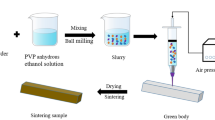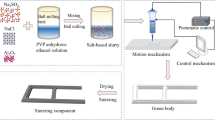Abstract
Core materials with high strength and excellent collapsibility are important for the manufacture of hollow composite structure castings. In this work, a novel technology to fabricate water-soluble Na2SO4-NaCl-based salt cores with high strength and low cost by material extrusion (ME) was reported. The water-soluble Na2SO4 and NaCl powders were used as the matrix materials, and the bauxite powder was used as the reinforcing material. The effects of bauxite powder content and liquid phase sintering parameters on the properties of the salt cores were studied. The results show that the salt-based slurry exhibits shear thinning property within the studied bauxite powder contents. When the content of bauxite powder was 20 wt.% and the sintering was at 630 ℃/30 min, the obtained salt cores show an optimal comprehensive performance, with the bending strength, linear shrinkage, water solubility rate, and moisture rate of 24.43 MPa, 6.3%, 207.6 (g/min·m2), and 0.29%, respectively. The complex water-soluble salt core samples prepared under optimal parameters display high-strength and well-shaped morphology.













Similar content being viewed by others
Availability of data and materials
The data used to support the findings of this study are included within the article.
References
Dong X, Yang H, Zhu X, Ji S (2019) High strength and ductility aluminium alloy processed by high pressure die casting. J Alloy Compd 773:86–96
Benedyk JC (2010) Aluminum alloys for lightweight automotive structures. Illinois Institute of Technology Press, USA
Alam T, Ansari AH (2017) Review on aluminium and its alloys for automotive applications. Int J Adv Technol Eng Sci 5:278–294
Wang T, Zha J, Jia Q, Chen Y (2016) Application of low-melting alloy in the fixture for machining aeronautical thin-walled component. Int J Adv Manuf Technol 87:2797–2807
Luo AA, Sachdev AK, Powell BR (2010) Advanced casting technologies for lightweight automotive applications. China Foundry 7:463–469
Kallien L, Weidler T, Becker M (2014) Production of magnesium die castings with hollow structures using gas injection technology in the hot chamber die casting process. Int Foundry Res 66:05–07
Jiang P, Liu FC, Fan ZT, Jiang WM, Liu XW (2016) Performance of water-soluble composite sulfate sand core for magnesium alloy castings. Arch Civ Mech Eng 14:494–502
Stauder BJ, Kerber H, Schumacher P (2016) Foundry sand core property assessment by 3-point bending test evaluation. J Mater Process Technol 237:188–196
Liu FC, Yang L, Huang Y, Jiang P, Li G, Jiang WM, Fan ZT (2017) Performance of resin bonded sand for magnesium alloy casting. J Manuf Process 30:313–319
Cho GH, Li J, Kim EH, Jung YG (2015) Preparation of a ceramic core with high strength using an inorganic precursor and the gel-casting method. Surf Coat Technol 284:396–399
Ke R, Dong Y (2021) Preparation and properties of water-soluble ceramic core for light alloy investment casting. Mater Today Commun 26:101918
Xiao Z, Harper LT, Kennedy AR, Warrior NA (2017) A water-soluble core material for manufacturing hollow composite sections. Compos Struct 182:380–390
Yaokawa J, Miura D, Anzai K, Yamada Y, Yoshii H (2007) Strength of salt core composed of alkali carbonate and alkali chloride mixtures made by casting technique. Mater Trans 48:1034–1041
Beňo J, Adámková E, Mikšovský F, Jelínek P (2015) Development of composite salt cores for foundry applications. Mater Technol 49:619–623
Jiang W, Dong J, Lou L, Liu M, Hu Z (2010) Preparation and properties of a novel water soluble core material. J Mater Sci Technol 26:270–275
Liu FC, Tu S, Gong XL, Li GJ, Fan ZT (2020) Comparative study on performance and microstructure of composite water-soluble salt core material for manufacturing hollow zinc alloy castings. Mater Chem Phys 252:123257
Gong XL, Jiang WM, Liu FC, Yang ZY, Guan F, Fan ZT (2021) Effects of glass fiber size and content on microstructures and properties of KNO3-based water-soluble salt core for high pressure die casting. Int J Metalcast 15:520–529
Jelínek P, Adámková E (2014) Lost cores for high-pressure die casting. Arch Foundry Eng 14:101–104
Sakoda T, Suzuki T (1976) Water soluble core for pressure die casting and process for making the same. US3963818A
Compton BG, Lewis JA (2015) 3D-printing of lightweight cellular composites. Adv Mater 26:5930–5935
Tang SY, Yang L, Li GJ, Liu XW, Fan ZT (2019) 3D printing of highly-loaded slurries via layered extrusion forming: parameters optimization and control. Addit Manuf 28:546–553
Li GJ, Tang SY, Yang L, Qian L, Jiang WM, Fan ZT (2019) Fabrication of soluble salt-based support for suspended ceramic structure by layered extrusion forming method. Mater Des 183:108173
Tang SY, Fan ZT, Zhao HP, Yang L, Liu FC, Liu XW (2018) Layered extrusion forming—a simple and green method for rapid prototyping ceramic core. Int J Adv Manuf Technol 96:3809–3819
Zhang YM, Shao HP, Lin T, Peng J, Wang AY, Zhang ZN, Wang LH (2019) Effect of Ca/P ratios on porous calcium phosphate salt bioceramic scaffolds for bone engineering by 3D gel-printing method. Ceram Int 45:20493–20500
Kleger N, Cihova M, Masania K, Studart AR, Lffler JF (2019) 3D printing of salt as a template for magnesium with structured porosity. Adv Mater 31:1903783
Jakus AE, Geisendorfer NR, Lewis PL, Shah RN (2018) 3D-printing porosity: a new approach to creating elevated porosity materials and structures. Acta Biomater 72:94–109
Qian L, Yang L, Li G, Jiang WM, Fan ZT (2020) Effect of nano-TiO2 on properties of 3 mol% yttria-stabilized zirconia ceramic via layered extrusion forming. J Eur Ceram Soc 40:4539–4546
https://www.crct.polymtl.ca/fact/phase_diagram.php?file=NaCl-Na2SO4.jpg&dir=FTsalt. Accessed 16 May 2020.
Tu S, Liu FC, Li GJ, Jiang WM, Liu XW, Fan ZT (2018) Fabrication and characterization of high-strength water-soluble composite salt core for zinc alloy die castings. Int J Adv Manuf Technol 95:505–512
Zhang HJ, Sun SL, Hiu HJ, Zhu Z, Wang YL (2020) Characteristic and mechanism of nugget performance evolution with rotation speed for high-rotation-speed friction stir welded 6061 aluminum alloy. J Manuf Process 60:544–552
Huang R, Zhang B (2017) Study on the composition and properties of salt cores for zinc alloy die casting. Inter J Metalcast 11:440–447
Funding
The authors would like to thank the support of the National Natural Science Foundation of China (No. 51775204 and 51971099) and the Analytical and Testing Center, HUST.
Author information
Authors and Affiliations
Contributions
Xiaolong Gong and Xinwang Liu designed and participated in experiments and wrote the manuscript draft. Zheng Chen and Zhiyuan Yang performed the experiments. Wenming Jiang analyzed the data. Zitian Fan directed this study, revised the manuscript, and provided the funding. All the authors read and approved the final manuscript.
Corresponding authors
Ethics declarations
Ethics approval
Not applicable.
Consent to participate
Not applicable.
Consent for publication
Not applicable.
Competing interests
The authors declare no competing interests.
Additional information
Publisher's note
Springer Nature remains neutral with regard to jurisdictional claims in published maps and institutional affiliations.
Rights and permissions
About this article
Cite this article
Gong, X., Liu, X., Chen, Z. et al. 3D printing of high-strength water-soluble salt cores via material extrusion. Int J Adv Manuf Technol 118, 2993–3003 (2022). https://doi.org/10.1007/s00170-021-08131-x
Received:
Accepted:
Published:
Issue Date:
DOI: https://doi.org/10.1007/s00170-021-08131-x




